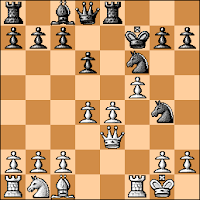The next day, I tried the Jerome again. He beat me again.
The following day was more of the same: I played the Jerome Gambit against MRBarupal and he beat me again!
Certainly it looked like I had met my match.
I admit, I took a day off, and then challenged my nemesis again. This time, in response to my blunder, MRBarupal came up with one of his own, and I was able to win – but that is a story for another day.
perrypawnpusher - MRBarupal
blitz, FICS, 2010
1.e4 e5 2.Nf3 Nc6 3.Bc4 Bc5 4.Bxf7+
4...Kxf7 5.Nxe5+ Nxe5 6.Qh5+ Ng6
7.Qd5+ Ke8 8.Qxc5 d6 9.Qe3 Qe7
The next day my opponent played the somewhat stronger 9...Nf6, when we reached an even Queenless middle game after 10.f4 Ng4 11.Qg3 Rf8 12.0-0 Qh4 13.Qxh4 Nxh4 14.d3 g5. MRBarupal effortlessly returned the piece for two pawns with 15.f5 h6 16.g3 Nxf5 17.exf5 Bxf5
analysis diagram
and out-played me again thereafter: 18.Nc3 Kd7 19.Bd2 Rae8 20.Rae1 Ne5 21.Nd5 c6 22.Ne3 Bh3 23.Rxf8 Rxf8 24.Re2 Nf3+ 25.Kh1 d5 26.Ng2 Nxd2 27.Nf4 gxf4 28.Rxd2 fxg3 29.hxg3 Rg8 30.Kh2 Bg4 31.Rf2 Ke6 32.d4 b6 33.Kg2 c5 34.Rf4 h5 35.dxc5 bxc5 36.Ra4 Rg7 37.Ra6+ Ke5 38.Rc6 c4 39.c3 Rb7 40.Ra6 Rxb2+ 41.Kg1 Rc2 42.Rxa7 Rxc3 43.a4 Rxg3+ 44.Kf2 Ra3 45.a5 d4 46.a6 d3 47.Ra8 d2 White resigned, perrypawnpusher - MRBarupal, blitz, FICS, 2010
In our third game MRBarupal tried a different kind of defense – or perhaps he was getting bored with me: 9...Nf6 10.0-0 b6 11.f4 Bb7 12.d3 Qe7 13.Nc3 a6 14.b3 Kd7 15.Ba3 Rae8 16.f5 Ne5 17.d4 Neg4 18.Qg5 Bxe4 His only slip, which could have been met with 19.Rae1 and an even game 19.Nxe4 Qxe4 20.Qxg7+ Kc8 21.h3 Rhg8 22.Qf7 Ne3 White resigned, perrypawnpusher - MRBarupal, blitz, FICS, 2010.
10.0-0 Nf6
Black has a solid game and is better. I have only two earlier games with this position in the updated New Year's Database, and Black won both.
11.Nc3 Rf8 12.f4 Ng4 13.Qg3 Nxf4
After the game I noticed that Rybka preferred 13...Qh4 here. There's a chance that MRBarupal checked that out, too, as in our second game (see above) he offered the Queen exchange.
14.Rxf4 Qe5 15.Rxg4
Trying to get fancy, and losing my advantage. Either 15.d3 or 15.Rxf8+ left White a pawn up, but I thought I saw a way to win more material.
15...Bxg4
16.Qe3
Just in time I realized that 16.Qxg4, winning two pieces for the Rook, would allow my opponent to checkmate me with 16...Qd4+ 17.Kh1 Rf1#
My best response would have been 16.Qxe5+ dxe5 playing on as in the game with a pawn for the exchange.
16...Qf6
17.h3
Instead, the White Queen had to go to Qe1 to safeguard the King.
17...Bd7
Missing a crusher: 17...Qf1+ 18.Kh2 Rf2 and Black wins a Queen for a Rook.
Now White can come close to balancing things with 18.Nd5.
18.d4 Rf7 19.Bd2 Kf8 20.Nd5 Qd8
21.Rf1 Rxf1+ 22.Kxf1 Kg8
White again is creeping back toward even. Unfortunately, because of being upset by the near-disaster on move 16, I thought that I was playing a Rook down, instead of just the exchange, which had a very negative impact on my resistance.
23.Qg3 Qf8+ 24.Kg1 c6 25.Nc3 Re8 26.Bf4 Re6
27.e5 dxe5 28.Bxe5 Rg6 29.Qe3
A better move was 29.Qh4, keeping Black's advantage from growing.
29...Qf5 30.Kh2 Qxc2 31.d5
A blunder in a position where Black was simply better.
31...Qxg2 checkmate
I was stunned after this game. After my third Jerome Gambit loss to MRBarupal, I didn't know what to think...






















































